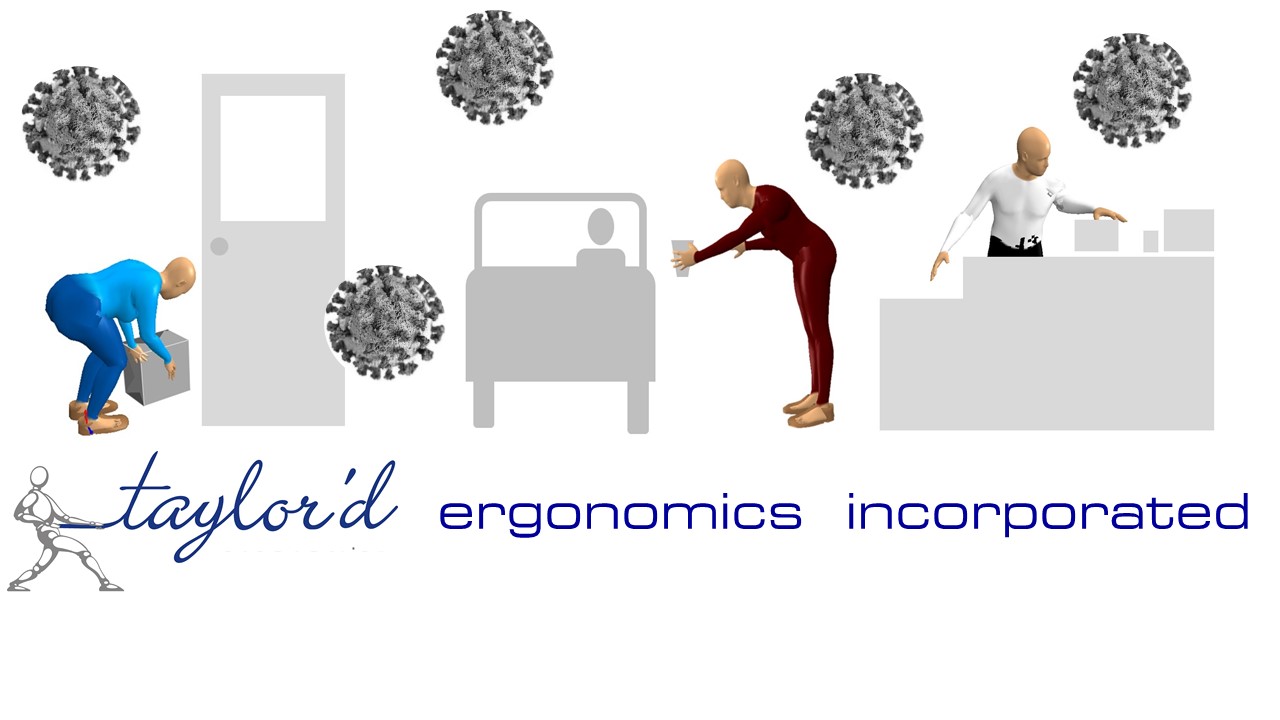The pandemic is going to change the way “we” work – and by “we”, we mean ergonomists, and all other workers. A recent broadcast email from the leaders of the Applied Ergonomics Society inspired this discussion of these emerging issues. What are your thoughts?
- How can we do ergonomics assessments while social distancing?
The need for MSD risk assessment and control won’t go away. In fact, for many jobs, the need for assessments will increase because the risk will increase. Ergonomists will need to take precautions, just like everyone else – gloves, masks, distancing to the extent possible. Telephoto lenses have never been more useful! Remote assessment technologies, that we are being “forced” to use right now, may open up doors to new methods of assessment in the future. And we’ve become much better at working with teams of engineers and stakeholders through video chat instead of in person.
- The workforce has been deconditioning at home for weeks or months. How can we help them get back to physical work, safely?
We’re working on some send-home work hardening challenges that companies can use to encourage people to prepare. (Let us know if you’re interested.) We can’t control whether employees follow our suggestions, but hopefully a few will recognize the need to prepare physically! During the ramping up phase, employers might consider providing more frequent breaks, or shorter shifts, to allow people to harden gradually.
- Can workers continue to rotate between jobs, without impairing workstation and equipment sanitization requirements?
We truly hope that we don’t have to stop job rotation altogether, as we are firm supporters of rotation as mitigation for repetitive demands! Hopefully, companies can select smaller pools of complementary jobs for rotation, so employees can rotate between jobs that are different in their demands. Even if an employee can only rotate between two jobs instead of 8 or 12, they will still benefit from muscle recovery by rotating between jobs with different demands. And if employees can’t rotate every 15 minutes, rotating less often will be better than not rotating at all.
- How can we ensure that items that are used by multiple employees, such as carts, hoists, and tools, are sanitized?
From the worker’s perspective, it’s probably best for each employee to be responsible for wiping down shared surfaces at the beginning of use, rather than assuming the previous worker has done so. (Since there is no way to “see” coronavirus, we also can’t “see” that sanitization has been done properly!) Workplaces will need to ensure adequate supplies of sanitizing materials, which may present a challenge as well! And employers also need to consider the increased demands on staff who are primarily responsible for sanitizing tasks. (We’re working on ergo training for them – stay tuned!)
- What issues might be introduced by face masks? Will the mask impair breathing, or increase heat stress? How can we ensure that masks, especially non-medical cloth masks, fit properly?
We expect that masks will create all of these concerns, as well as impair verbal and visual communication. Just like gloves, employers will need to provide a variety of sizes and fits, and might offer employees the option to bring their own, once parameters of acceptability have been established. We imagine that rapid innovation (supply and demand!) will result in designs that reduce the insulative value (are cooler), don’t retain moisture (are easier to breathe through), and are more transparent (for improved communication). In the interim, we hope that employees will have some fun with their masks, allowing some creative expression.
- How can we support remote workers in what may be less than ideal conditions?
We’ve already shared our presentation to support home office employees, and we are doing remote assessments for home office workers. If employees will be working from home on a long-term basis, employers should be supporting them with equipment that will allow them to be comfortable and productive. The kitchen table only works for so long.
- How can we modify the workplace with barriers to protect employees in close proximity?
Our friends at EZObord have ideas about that! We’re excited to see what innovations will be developed to optimise communication between employees, airflow, and aesthetics. We’ve spent the past decade increasing workplace density – fitting more people and equipment into smaller footprints. It will be challenging to reverse this trend.
- Should workers be allowed to leave the workplace at lunch?
Leaving for lunch doesn’t sound any more ominous than going home at the end of the day. Employees need fresh air. If they are distancing appropriately and following effective hand-washing procedures, whether they take breaks in- or out-side of the building seems irrelevant. If more people go home or outside for lunch, the lunchrooms will be less crowded!
Please feel free to open a dialogue about these issues, in the comments below. We’re interested in your experiences, needs, and concerns!


